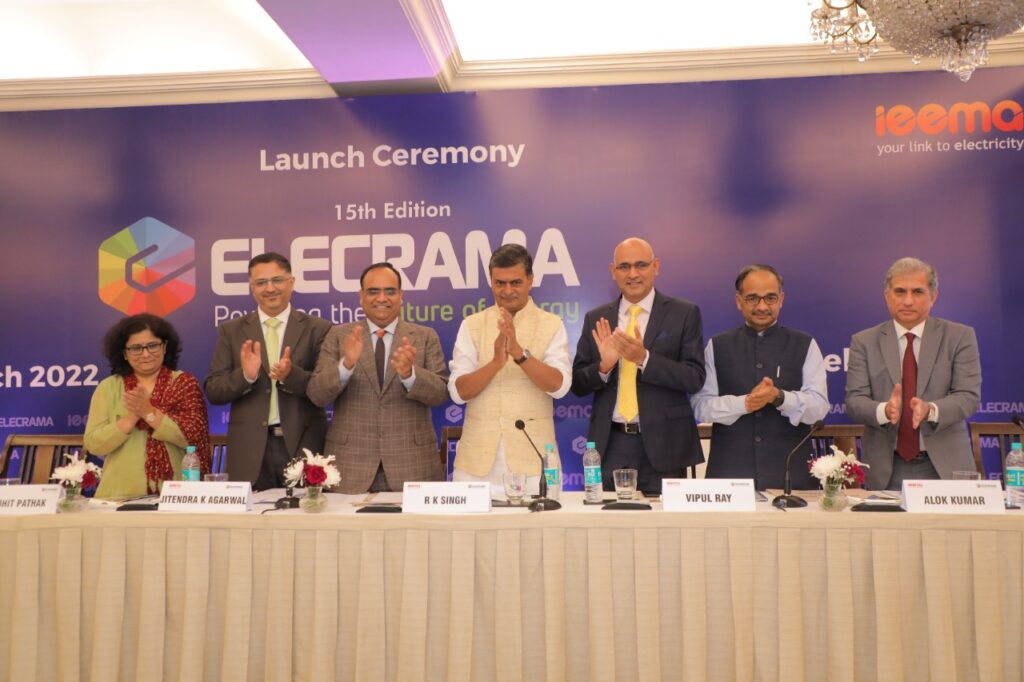The Union power minister R.K. Singh emphasized that India, thanks to its ongoing energy transition, will be the biggest market in the world for electrical equipment, at least up to 2030.
Singh was speaking at an event to launch “ELECRAMA 2023” – India’s premier trade event organized by apex industry body Indian Electrical & Electronics Manufacturers’ Association (IEEMA) – in New Delhi, on March 16, 2022.
ELECRAMA 2023 will be held during February 18-22, 2023, at the India Expo Mart, Greater Noida, This will be the 15th edition of the biennial event, which was launched way back in 1990.
R.K. Singh reiterated that the Indian power sector is in a multidimensional transformation phase. Every aspect of the power value chain is undergoing a transformation of sorts, the minister felt.
For instance, in power generation, India has cumulatively added around 1,60,000 mw of non-fossil fuel generation capacity. This accounts for around 45 per cent of the total installed power generation capacity. Singh asserted that this target – for share of non-fossil fuel capacity – has been achieved at least nine years ahead of the committed date. In the power transmission sector, India has added 1.62 lakh ckm of transmission lines since 2015, Singh noted.
In rural areas, electricity availability has sharply improved from 12 hours a day in 2015, to around 23 hours per day today, on a national average basis.
Power distribution will continue to see major investment, Singh asserted. This is where the engagement of the electricity equipment industry – and therefore IEEMA members – will deepen, Singh said. Over the past two years, over Rs.2 trillion has been invested in the power distribution sector, and over the next 4-5 years, another Rs.3 trillion will be deployed, especially under the Revamped Distribution Sector Scheme (RDSS).
Import substitution
R.K. Singh strongly felt that India’s dependence on imports should reduce. He believed that several electrical equipment items currently imported could very well be produced domestically. Confident that India will be the biggest market for the power sector, up to 2030 at least, Singh expressed his view that the world should come and manufacture here (in India). India has embarked on “energy transition at a scale that has not been seen anywhere in the world, Singh felt.
Corroborating the views of R.K. Singh was Alok Kumar, Secretary, Union power ministry. Alok Kumar strongly expressed that the main objective and benefits of this energy transition should flow to the local people, including local employment opportunities. “India will not be able to sustain a situation where the rewards of this growth go to other countries,” Alok Kumar cautioned.
Role of IEEMA
Alok Kumar also acknowledged the Indian electrical equipment industry for having met the demand arising out of the massive rural and household electrification works undertaken in states like Uttar Pradesh, in the recent past. “IEEMA has risen to the occasion and has contributed to the transformation of the Indian power sector,” Alok Kumar remarked.
Also read: Semiconductors PLI Scheme Is A Positive Step, Says IEEMA
Energy transition
The main objective of ELECRAMA 2023 would be to address issues on energy transition. As pointed out by Vipul Ray, President, IEEMA, “The 15th edition of ELECRAMA will focus on opportunities in positioning India at a fulcrum of futuristic technologies and solutions required for sustainable growth, and towards our commitment towards Net Zero.”
Vipul Ray also highlighted IEEMA’s vision for the year 2047. IEEMA has envisioned per capita energy consumption to grow 8 times – reaching 10,000 kwh in 2027 from around 1,200 kwh now. [Per capita consumption is the average annual consumption, per person.]
Ray also recalled Prime Minister of India, Narendra Modi’s vision of making India energy independent by 2047. Pledging IEEMA’s support to this national objective, Vipul Ray said that this was a big encouragement to the electrical equipment industry.
In his address, Rohit Pathak, Senior Vice President, IEEMA, said that India’s energy transition goals would rest on six key planks – clean energy and storage at scale; Green corridors & quality transmission network; digitalization and reliability of distribution networks; electrification of transportation; urbanization & smart factories/buildings; and, green hydrogen ecosystem.
Green hydrogen
Much emphasis was laid on green hydrogen as a focus area – not just for ELECRAMA 2023 but as an enabler of India’s energy transition. R.K. Singh strongly felt that green hydrogen could be an area where India can acquire global dominance. “We want to emerge as the world’s largest source of green hydrogen,” Singh asserted. The minister also alluded to the possibility of introducing new official mandates where “grey” hydrogen would need to be replaced by green hydrogen, and “grey” ammonia with green ammonia – in industries like fertilizers.
All about electricity
Recounting the success of ELECRAMA over the years, Jitendra Agarwal, Chairman, ELECRAMA 2023, observed that the number of exhibitors has increased from around 100 in 1990 (the first edition) to over 1,200 in the latest edition in 2020. Agarwal expressed confidence that the upcoming edition of ELECRAMA will only aggrandize the event’s scale. The event will aim to showcase futuristic technologies and will be equipped with other features like World Utility Summit, Reverse Buyer Seller Meets, Innovation Hub, etc. Agarwal said that electricity will be the preeminent form of energy in the years to come. “The future of energy is electricity and we (IEEMA) are all about electricity,” was how Agarwal summarized IEEMA’s role in India’s electricity sector – both as a representative of the industry in government forums, and as organizers of the world’s largest trade exhibition in the power sector – ELECRAMA.

